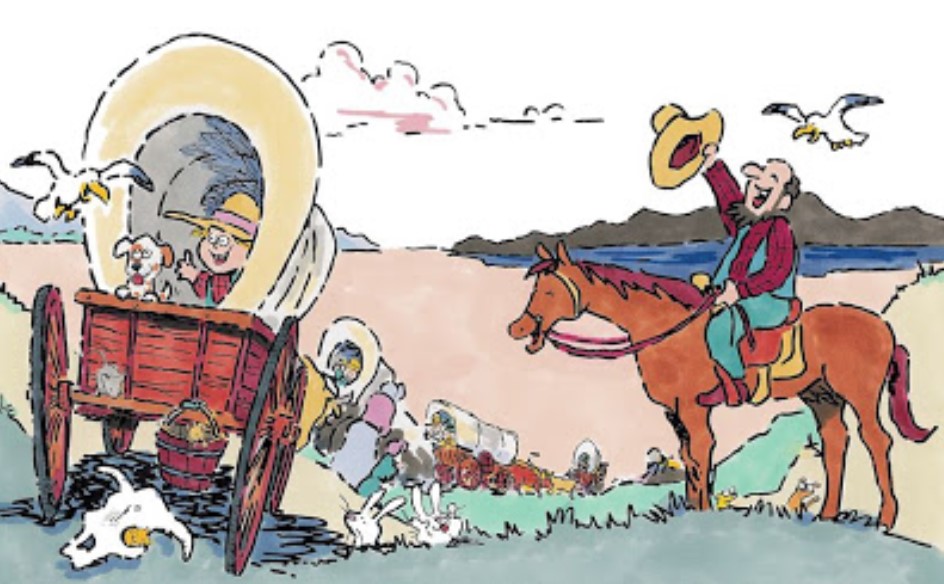Utah’s Flag on Utah’s Day
John Hartvigsen
Utah’s great holiday, Utah’s great state flag, and Utah’s history intertwine in celebration of Pioneer Day every July 24th, and like the nation’s Independence Day that is known simply as the Fourth, Pioneer Day is known locally as the Twenty-fourth. This may seem strange to visitors or those new to the state, and some locals may find it irritating that so much emphasis is given to the settlers of 1847. Their arrival in the Salt Lake Valley comprises only one event of Utah’s storied history. However, the Pilgrims and Plymouth Rock are remembered and celebrated in Massachusetts, William Penn stands atop city hall in Philadelphia remembering his role in founding Pennsylvania, and the nickname “Land of Lincoln” identifies Illinois, acknowledging Lincoln’s role in the state’s history. It is equally appropriate to celebrate the early settlers of Utah who laid the footings upon which many who followed built the foundations upon which modern Utah rests.

Based on the design of Utah’s Great Seal, which was adopted in 1896, the Utah State flag’s beautiful current design was created by Utah artist Perry Van Schelt in 2011.
The Utah State flag encapsulates more than just Utah’s founding. The flag depicts symbols which relate stories of Utah’s founding and growth.
- Skep Beehive. Central on a shield appears the skep (straw cone shaped hive) beehive, and it identifies Utah at home, in the nation and around the world. Utah is the Beehive State, the state emblem is the beehive, the state insect is the Honey Bee, the state astronomical symbol is the beehive cluster, and the state exhibits a prolific array of beehives and bees. Visiting Great Salt Lake City in 1861, Mark Twain pronounced “Utah’s crest” the perfect symbol for Utah and her residents, “And it was simple, unostentatious, and fitted like a glove. It was a beehive, with all the bees at work!”
- Honey Bees. As Twain noted, honeybees swarm around the hive. A skep beehive is just an upside down straw basket without its colony of bees, and Utah’s residents have been and are an industrious lot. The Honey Bee is Utah’s official State Insect and completes the beehive on Utah’s flag.
The hard-working nature of Utahns is proclaimed by the Utah State Motto, INDUSTRY, which is lettered above the Beehive beset with bees. Describing farmers, miners and tradesmen of Utah in early years, it now recognizes Utah’s vibrant economy that serves as a model for the nation. Businesses from all around the country relocate to Utah recognizing that Utah is the place. - Sego Lilies. The State Flower (Calochortus nuttallii or Sego Lily) grows on each side of the Beehive. These wildflowers produced gorgeous blooms that challenged the rugged desert clime long before pioneer settlers arrived in the Great Basin. Utes and Paiutes, who had learned how to live off the land, ate the plant’s bulbs and shared this knowledge with early settlers, who also ate the bulb in their days of food shortage.
- State’s Name. The Ute tribe is commemorated by the state’s name, UTAH, which appears in block letters below the hive. The Spanish called tribes living in our boundaries the Yuta, which is said to be derived from other tribal languages spoken by neighboring Navajos and Apaches. It may have come from the Apache word Yuttahih, which means “one that is higher up” or “those that are higher up.” However the state’s name originated, it honors the Ute tribe.
- Arrows. Placed at the top of the shield is another symbolic representation of the peoples that roamed the area before the arrival of pioneer settlers. Six arrows pierce the shield that represent bands of the Shoshone nation: the Shoshoni, the Bannock, the Utes, the Paiute, the Goshutes along with the Navajo.
- Two Years. Numerals for two years describe a period known as the “Struggle for Statehood” with 1847 appearing below the word UTAH and 1896 placed below the shield. Congress created a Utah Territory in 1850 but rejected repeated petitions for statehood until 1895. Utah’s size grew smaller as a ring of surrounding states gained admittance with Nevada, Colorado and Wyoming each taking a chunk of Utah lands upon admission. Finally, in 1896, Utah’s rising star finally appeared in Old Glory as the 45th state entered the union.
- Flags & Bald Eagle. Celebrating Utahns demonstrated their excitement by making what was then the world’s largest flag, which measured 74 by 132 feet for display at Utah’s inauguration. The flag declared, “We finally made it! Utah is a state.” This excitement appears on the state flag with two U.S. flags with crossed flagstaffs placed behind the shield and a bald eagle perched atop the shield. First used for the Great Seal of Utah, a golden ring surrounds and completes this pattern, which is placed on a blue field.
In recent years, flag re-design activists—yes, they really do exist—have busied themselves lobbying various state legislature to discard flag designs that activists have branded as “bad flags.” Flags are not just about design. Symbolism is a chief component that gives a flag meaning, and the people who fly a flag give a banner its ultimate meaning. Design, symbolism and history join together to create a successful flag. Utah’s flag is known, recognizable and beautiful. A Great Flag for a Great State.

The United States flag and the Utah State flag grace the Utah State Capitol’s Gold Room and provide Utah’s Governor, Gary R. Herbert, with a favored setting for interview and press photos.
The Twenty-fourth of July, Pioneer Day, and the Utah State Flag encourage us to embrace Utah’s history as together we open new doors to the future.

